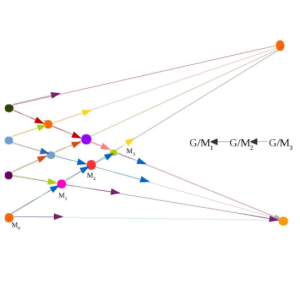As part of our series of research articles deliberately focusing on the rigour and intricacies of mathematics and its problems, Oxford Mathematician Nikolay Nikolov discusses his research in to Sofic Groups.
"In the first year of mathematics at Oxford we learn Cayley's theorem that every finite group is isomorphic to a subgroup of the symmetric group $S_n$ for some integer $n$. Many problems in group theory are motivated by analogues of Cayley's theorem where we want to approximate a general infinite group $\Gamma$ by permutations. One far reaching generalization of such approximations is the notion of sofic group. Roughly speaking instead of a homomorphism from $\Gamma$ into $S_n$ we insist that for any $\epsilon >0$ there is a map from $\Gamma$ to $S_n$ which is '$\epsilon$-close' to being a homomorphism. One slick way to define this is using the notion of ultrafilters and ultralimits from logic. For the definition of ultrafilters and ultralimits you can consult https://en.wikipedia.org/wiki/Ultralimit.
For a permutation $\pi \in S_n$ let us denote by $r_n (\pi)= \frac{\mathrm{mov} (\pi) }{n}$ where $\mathrm{mov} (\pi)$ is the number of points moved by $\pi$. The distance function $d_n(x,y)= r_n (x^{-1}y)$ is called the Hamming metric on $S_n$. For a nonprincipal ultrafilter $\omega$ on $\mathbb N$, let $M_\omega$ be the metric ultraproduct of the groups $S_n$ with respect to their metrics $d_n$. More precisely $M_\omega$ is the quotient group $\frac{G}{K_\omega}$ where $G=\prod_{n=1}^\infty S_n$ and $K_\omega$ is the set of sequences $(\pi_n)_n$ with $\pi_n \in S_n$, such that the ultralimit of the sequence $r_n(\pi_n)$ is $0$. As an exercise you can check that $K_\omega$ is indeed a normal subgroup of $G:=\prod_n S_n$.
A countable group $\Gamma$ is sofic if $\Gamma$ is isomorphic to a subgroup of $M_\omega$. It turns out that this definition does not depend on the choice of $\omega$.
It is a major open question in group theory whether every group is sofic. If true this will imply several other conjectures, for example Kaplansky's Direct Finiteness Conjecture: If $\Gamma$ is a group, $K$ is a field and $a,b$ are two elements of the group ring $K[\Gamma]$ such that $ab=1$, then $ba=1$. Many groups are known to be sofic, for example abelian groups, solvable groups and linear groups (subgroups of $GL(m,K)$ for a field $K$).
We don't know if every group is sofic but we know a little about the groups $M_\omega$: these are simple uncountable groups. In fact the $M_\omega$ together with $C_2$ are all the simple quotients of $G$. The group $G$ with the product topology is an example of a compact Hausdorff group, like the circle $S^1$ and its generalizations the unitary groups $U(m)$. One difference which sets $G$ apart from $U(m)$ is that while unitary groups are connected, our $G$ is totally disconnected (i.e. its connected components are singletons), in fact $G$ is topologically homeomorphic to the Cantor set). A compact Hausdorff group with this property is called a profinite group.
So in order to find out whether every group is sofic we first need to know about the quotients of compact groups. One step in this direction was taken by me and Dan Segal where we proved the following theorem: a finitely generated quotient of a compact Hausdorff group must be finite. If in addition the compact group is connected then one can deduce that the quotient must be in fact the trivial group. Dan Segal and I also showed that the presence of abelian groups is responsible for the existence of countably infinite quotients of compact groups. For example the circle $S^1$ does not have a finite quotient but has a countably infinite quotient (Exercise: prove this!). The same is true for any infinite abelian compact group.
Some other recent results on sofic groups can be found here."


